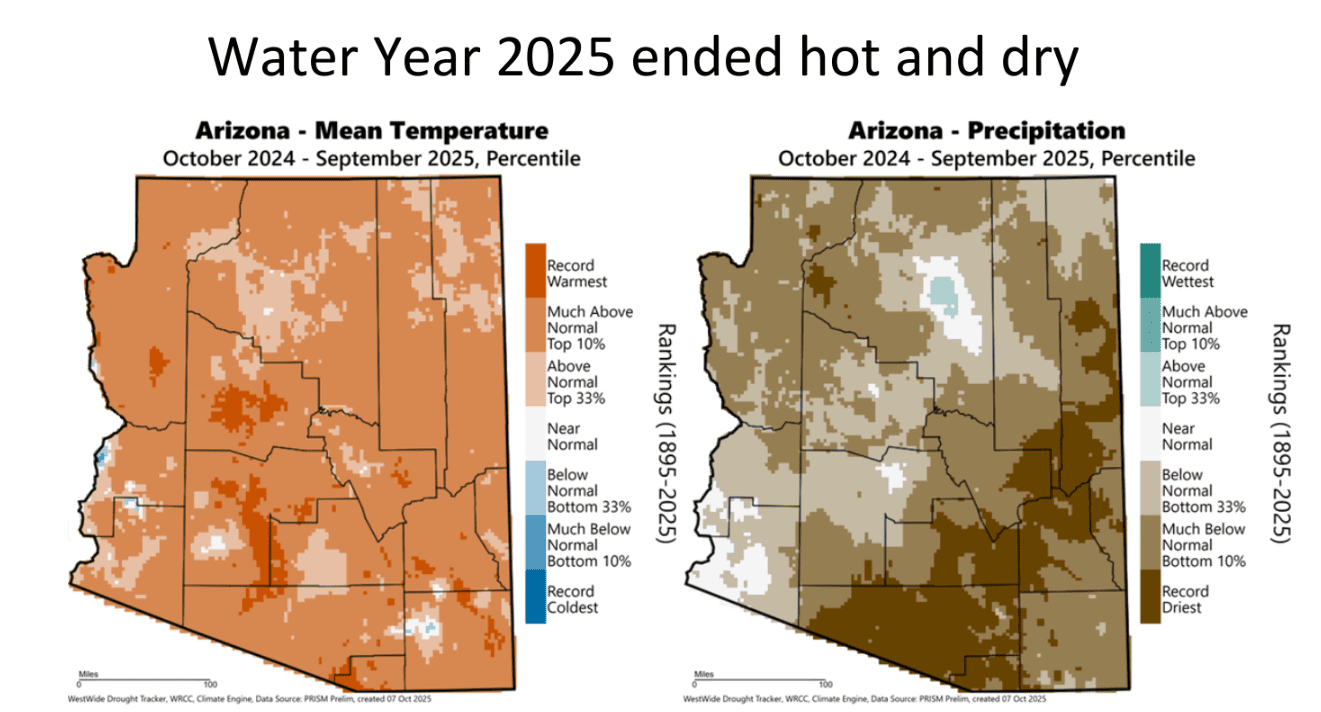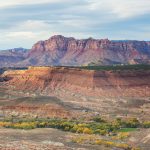- Arizona’s drought emergency and drought declaration remain in effect.
- Weak La Niña could bring another warm, dry winter.
- Soil moisture gains may help snowpack runoff reach reservoirs.
- Hydropower, forests and watersheds remain under stress.
Monday, November 17, 2025 –– Arizona will continue operating under both its longstanding drought emergency declaration and its statewide drought declaration, following recommendations made at the Drought Interagency Coordinating Group meeting held on November 12 . The panel reviewed the state’s hydrologic conditions, current drought status and seasonal outlook before advising the Governor to keep the declarations in place.
. The panel reviewed the state’s hydrologic conditions, current drought status and seasonal outlook before advising the Governor to keep the declarations in place.
The recommendation comes as the Southwest enters its third decade of drought. Meteorologists reported that the months ahead may once again lean warmer and drier than historical norms, a pattern that has shaped much of the region’s recent water challenges.
La Niña Signals Another Dry Winter.
Mark O’Malley of the National Weather Service shared the latest climate assessment with the panel. He reported that the eastern Pacific Ocean is experiencing a weak La Niña, a climate pattern commonly associated with drier winter conditions in Arizona. If the pattern persists, it could reduce the state’s ability to build the mountain snowpack that replenishes reservoirs in spring.
O’Malley noted that the region’s soils have often entered winter unusually dry in recent years, causing spring runoff to soak into the ground rather than flow into river systems. However, storms in late September and early October brought timely rainfall that helped moisturize the watershed.
“I’m going to bring a glimmer of hope here, but just a glimmer,” he said , adding that the early-season storms may slightly improve runoff efficiency once snow begins to melt.
, adding that the early-season storms may slightly improve runoff efficiency once snow begins to melt.
What the Panel Reviewed.
The Drought Interagency Coordinating Group, co-chaired by Arizona Department of Water Resources Director Tom Buschatzke, examined several indicators of water and climatic conditions. Topics included:
-
The status of drought metrics across short- and long-term timescales.
-
The 2025 to 2026 water-year outlook, including expected precipitation, snow-water-equivalent and likely river and reservoir inflows.
-
Water-supply conditions in the Colorado River Basin and in Arizona’s major in-state watersheds such as the Salt and Verde Rivers.
-
The influence of drought on hydropower production and energy reliability.
-
The condition of Arizona’s forests and wildfire risks associated with prolonged heat and dryness.
Director Buschatzke cautioned that projections remain concerning . “The trends are definitely going in a hot and dry direction,” he said. “There cannot be much expected in the way of a turnaround.”
. “The trends are definitely going in a hot and dry direction,” he said. “There cannot be much expected in the way of a turnaround.”
Statewide Water Stress Still Dominates the Picture.
Despite isolated areas of recent rainfall, the Interagency Coordinating Group described Arizona as a state still experiencing significant water stress. The panel reported several ongoing challenges:
-
Reduced snowpack in critical headwater regions and limited runoff needed for reservoir recovery.
-
Forecasts for below-average inflows into the Colorado River and its tributaries.
-
Increasing pressure on hydropower generation as reservoir elevations decline.
-
Heightened wildfire risks and declining forest health, which can directly affect watershed stability and future water-supply reliability.
Why the Declarations Remain in Effect.
By recommending a continuation of the drought emergency and drought declaration, the panel reinforced the value of maintaining an established framework for drought monitoring, planning and response. The declarations support coordination across state, federal, tribal and local entities and allow agencies to operate under a shared understanding of current conditions.
The recommendation will be transmitted to the Governor for review.
Image from the Arizona Department of Water Resources’ news release.
Frequently Asked Questions.
Why does a weak La Niña matter for Arizona?
A weak La Niña often brings warmer and drier winter conditions to the Southwest. For Arizona, this pattern can reduce winter snowfall in the mountains, which limits the water available to flow into rivers and reservoirs during spring runoff.
What is the role of the Drought Interagency Coordinating Group?
The panel serves as an advisory body to the Governor. It evaluates hydrologic and climatic data, reviews statewide drought conditions and recommends whether existing drought declarations should remain in place.
Do drought declarations affect residents directly?
The declarations do not impose restrictions on residents. They establish a formal mechanism for monitoring, preparedness and coordinated response across various levels of government and community partners.
How did early autumn storms help the state?
Storms in late September and early October improved soil moisture in the mountains. When soils retain more moisture before winter, a greater share of snowmelt can reach rivers and reservoirs instead of being absorbed into the ground.
Is the Colorado River Basin included in these drought concerns?
Yes. The panel reviewed current conditions in the Colorado River Basin and noted that below-average inflows are expected, continuing the long-term strain on reservoir storage and hydropower operations.





